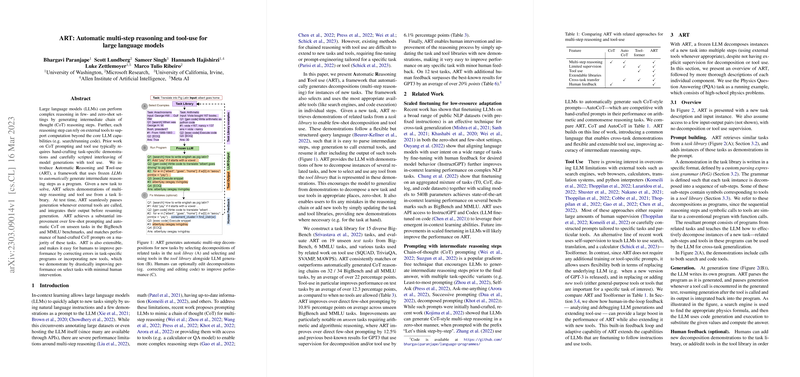Overview of ART: Automatic Multi-Step Reasoning and Tool-Use for LLMs
The paper introduces Automatic Reasoning and Tool-use (ART), a framework designed to enhance the performance of LLMs in executing multi-step reasoning tasks and utilizing external tools. LLMs have demonstrated significant potential in performing complex reasoning tasks in few-shot and zero-shot settings by generating intermediate reasoning steps, known as chain of thought (CoT) steps. However, traditional CoT prompting and tool usage often rely on task-specific demonstrations or a careful orchestration between model-generated content and tool employment. ART aims to automate this process without requiring additional finetuning of the LLM.
Core Contributions
ART's primary contribution is its ability to dynamically generate reasoning steps as a program by using a frozen LLM, integrating tool use seamlessly when external computation is necessary. The framework achieves this by employing a library of task demonstrations and a selection mechanism to choose related tasks for few-shot learning. ART's design allows generation to pause when a tool is needed, incorporate the tool’s output, and then proceed with the reasoning process.
Numerical Results
Evaluation of ART shows it achieves significant improvements over few-shot prompting and automatic CoT on unseen tasks across multiple benchmarks like BigBench and MMLU. In particular, ART outperforms traditional few-shot learning approaches on unseen tasks by 10.8% on average, with the tool-use component contributing an additional improvement of over 12.3 percentage points. ART's performance is competitive with hand-crafted CoT prompts on many tasks, with a noted enhancement in arithmetic and algorithmic tasks.
Practical and Theoretical Implications
Practically, ART's framework offers an extensible system that allows human users to enhance task performance by adding new tools or correcting errors with minimal intervention. This adaptability implies that ART can assimilate more sophisticated tools or integrate updated information, broader knowledge, and emerging computational techniques seamlessly. Theoretically, ART propels forward the methodology for improving LLM's execution abilities without altering their core architecture, potentially transforming how models can be enhanced in high-stakes domains like legal reasoning, scientific exploration, and complex data manipulation.
Future Developments
The paper hints at exciting potential trajectories for AI development. Future LLM iterations with scaled finetuning could unlock even greater utility from ART. Furthermore, the adaptive framework suggests potential for cross-task transfer learning, where learning and tool-use improvements can be systematically leveraged across varied domains, opening new avenues for LLM deployment in multidisciplinary fields.
In conclusion, ART represents a step forward in automating reasoning and tool use with LLMs, broadening the sophistication and applicability of these models in handling diverse, real-world tasks. The framework sets a precedent for future AI systems’ capacity to extend their reasoning capabilities beyond static modeling, coupling learned operations with dynamic, computationally potent tool interactions.
